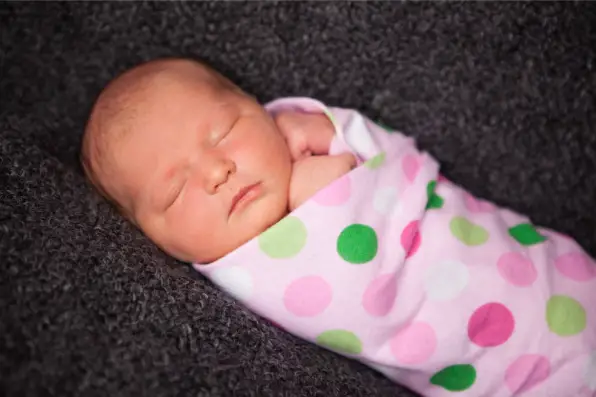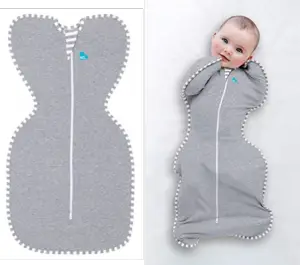A question that most new parents have, particularly when the winter season is coming, is “How to dress baby for sleep?”. Babies are too little to communicate when it’s too hot or cold for them, so it’s often a guessing game. But here are some tips on how to figure it out and make sure your baby sleeps comfortably at night.
Related: Baby waking up multiple times a night: here’s what you need to know.
The Room Temperature
Let’s start by talking about the room temperature first! What you are going to put on your baby is going to be highly dependent on the room temperature. But did you know that there’s an ideal temperature that allows your little one to be comfortable and safe when sleeping? It is actually a range and experts recommend a temperature between 18 and 21 °C (65-72 °F).
If you are not sure of the temperature in your baby’s room, just use a thermometer. What I found to be very useful is having a monitor with a thermometer as well, so that I can monitor the temperature throughout the day or night. The Motorola baby video monitor is an excellent example.
How to regulate the temperature in the room
But once you know the temperature, how do you regulate it and make sure that it doesn’t change too much through the night?
I live in New Zealand, where the temperature drastically drops overnight, even in summer. You could go to bed with 26 °C and wake up with 20 °C at 2 am. So it can be a real challenge to keep the temperature within a small range throughout the whole night!
This is what I do to keep the temperature almost constant in the room at night:
- In winter: I use a heater with a thermostat. I set the temperature to 19 °C and the heater automatically turns off if the temperature goes above that. I use a De’Longhi one, but there’s other brands that you can look into.
- In summer: I use a thermostat plug to plug the fan into the wall. I set the temperature to 24 °C, so that when the temperature in the room goes below that, the plug automatically cuts the electricity to the fan and it turns off.
If you can’t use a heater or a fan to keep the room within the recommended range of 18 and 21 °C, that OK too! It doesn’t mean that your baby won’t be able to sleep comfortably. It just means you may need to add some extra layer of clothing if colder, or strip them off if warmer.
How to dress Baby for Sleep
Here’s some guidelines on how to dress your baby for sleep depending on the room temperature, and depending on the age of the baby. Remember this is just a guideline! Each baby is a little bit different and you may need to adjust the layers of clothing depending on their comfort level.
However, a great rule of thumb is: dress baby in ONE additional layer compared to what you are comfortable wearing at night in the same room.
Infants / Newborns
Before your infant starts to roll, usually around the 3-4 months mark, they can either sleep with:
- A swaddle (or swaddling blanket)
- A sleeping bag (or sleeping sack)
- A blanket
These can also all be perfect pacifier alternatives if you are tying to get rid of or you don’t want to use a pacifier, as they provide comfort and safety to your child.
A lot of people (midwifes, pediatricians, sleep consultants, etc.) recommend a swaddle for the first few weeks of life. That is because of the benefits listed below. However, know that every child is different and not all children like to be swaddle! I personally didn’t swaddle my babies. Well, I tried to but they only liked it for the first few days after birth. After that they hated it, so I just put them to sleep with a blanket.
The American Academy of Pediatrics (AAP) recommends keeping loose bedding out of the sleeping area for at least the first 12 months of your baby’s life. This recommendation is based on data around infant sleep deaths and guidelines for reducing the risk of SIDS. However, I found that my babies were so still during the first months of life, that I felt totally safe putting them to sleep with a blanket.
If you are swaddling, you need to stop as soon as your baby starts rolling, so that their arms can be free.
If you have a baby girl, make sure to check out this list of best baby girl blankets, including swaddling blankets for some ideas on the best products and fabrics depending on your climate and needs.
The Benefits of a Swaddling a Baby

If you are considering swaddling your baby, these are the main benefits:
- It recreates the secure and cozy feeling of the womb, making the transition from mom’s belly to the world easier. For this reason, it is actually one of the best tips to soothe a crying baby.
- It mimics a parent’s soothing touch and helps baby have longer, more restful sleep with fewer disturbances.
- It alleviated the effects of the Moro reflex, also called startle reflex, which is a normal neurological response which causes a newborn to feel as though they are free falling. Babies experience this all the time within the first 3 to 4 months of life and it can disturb their sleep, as they have involuntary movements that can easily wake them up. Swaddling helps prevent those spontaneous movements, allowing for a much more peaceful sleep.
- If made of breathable material, such as cotton, it helps regulate the baby’s body temperature and prevent overheating.
- It helps alleviate colic by applying a light pressure to baby’s belly and, therefore, providing relief.
- It helps babies maintain their safe sleep position, hence reducing incidents of SIDS.
Overall, it gives the baby a sense of comfort, warmth and security.

What if my Baby hates Swaddling?
If your baby hates swaddling, and you don’t feel comfortable putting them to sleep with just a blanket or in a sleeping bag, Love to Dream has come up with a perfect solution: the Love to Dream Swaddle UP. The main difference from the traditional swaddle is that it has two wings that allow babies to sleep in their natural arms up position, instead of restricting their arms movement down. This way they can self-soothe by touching their face and sucking on their hands, just like they did in the womb.
I know a lot of parents who have used this successfully and were very happy with the result.

They even have a transition swaddle to help your baby transition from a swaddle to a sleeping bag when they are ready to roll. This swaddle has detachable wings to free your baby’s arms when they are ready.
Babies
When your baby learns how to roll over, it is not safe to continue to use a swaddle which constrains the arms. A blanket or any other loose bedding also becomes unsafe. At that age it is better to dress your baby in a sleep sack which allows their arms to be free and for them to move around easily without getting cold.

You can keep using a sleeping bag until your baby is ready to transition to a blanket / duvet. That usually happens when they get close to 2 years old and are able to put their blanket back on themselves after they kick it off.
Related:
- 10 Best Baby Sleeping Bags for Summer (0.5 and 1 TOG)
- 8 Best Baby Sleeping Bags for Winter (2.5 and 3.5 TOG)
What to wear underneath a Swaddle or Sleeping Bag
Underneath a swaddle or sleeping bag, your newborn / baby can wear a long-sleeve onesie and/or a bodysuit (long or short-sleeve). You can add or remove layers of clothing depending on both the temperature of the room and the material of the swaddle or sleeping bag.
These usually have a TOG rating, which is a reflection of the product’s warmth. The higher the TOG, the warmer the products.
For more information on what to wear exactly underneath a sleeping bag (or swaddle), depending on both the temperature and TOG rating, refer to this related article: Baby Sleeping Bag: TOG Guide
Is you Baby too hot or too cold?
If your baby is not comfortable, they will let you know by waking up during the night, and it won’t be for hunger. To make sure they are waking up because they are too cold or too hot, check the back of their neck (or their tummy):
- If it feels damp, then they may be too hot.
- If it feels nice and warm, then they are fine and they are waking up for other reasons.
- If it feels cold, the they may be too cold. But usually when they are too cold, they are very good at letting you know!
Don’t worry if their arms, hands or feet are a it cold: this is normal. It their bodies’ way of maintaining a regular temperature.
It is best not to have them wear a hat or hood as this can cause them to overheat. It is better for your baby to be cool rather than hot. Also, make sure clothing is made of cotton and breathable.
Do you have other tips or recommendations on how to dress baby for sleep? Then please feel free to comment below and let me know. I’d love to hear your ideas 🙂
Did you find this useful? Pin It!



